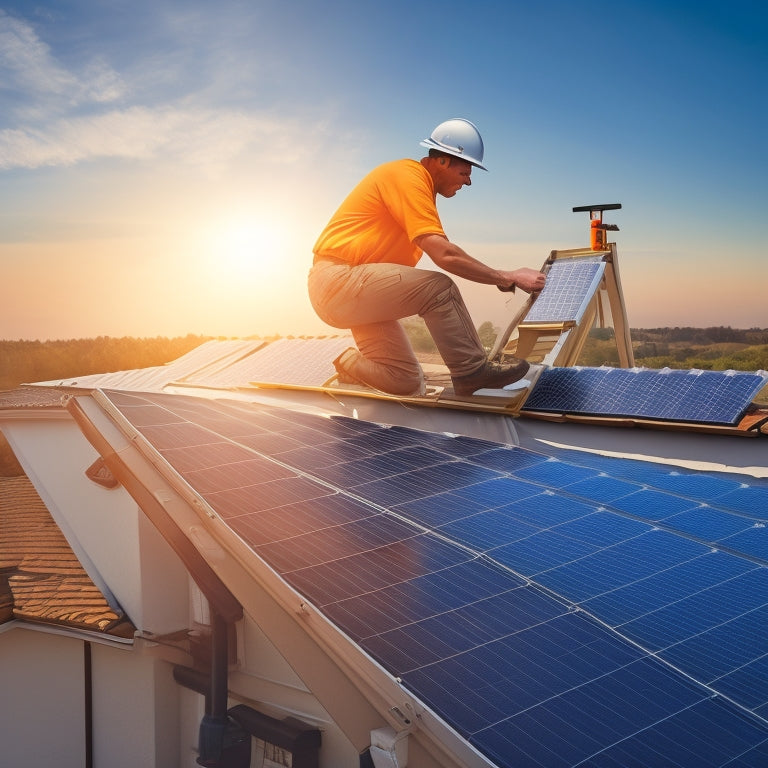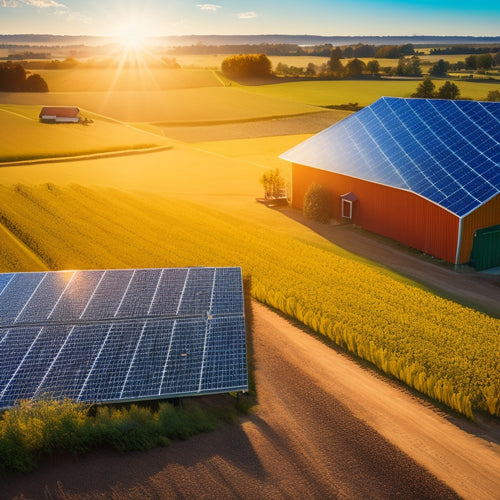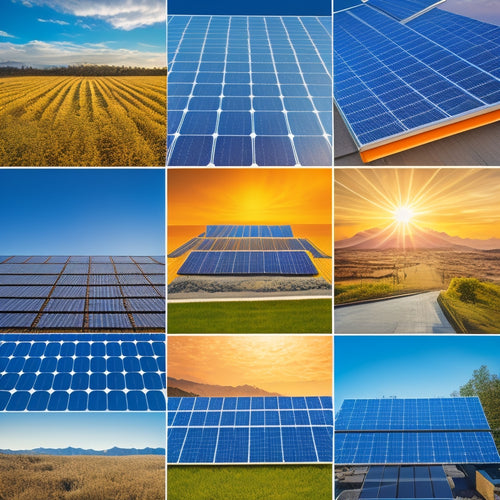
10 Steps to Assess Your Roof Space for Solar Panels
Share
You're about to invest in solar panels, and your roof's suitability is the first hurdle to overcome. Start by evaluating your roof's size, shape, and space availability, considering obstacles like vents and chimneys. Next, assess its orientation and angle, as south-facing roofs are most efficient. Then, inspect the roof's age and condition, material, and type, as these factors impact installation and performance. Don't forget to identify roof obstructions and shading patterns, and check local building codes and regulations. By following these initial steps, you'll be well on your way to determining whether your roof is ready for solar panels - and what it'll take to get started.
Key Takeaways
- Measure roof dimensions, identify obstacles, and calculate available space for optimal solar panel installation and layout.
- Assess roof orientation and angle, considering ideal ranges for efficiency and alternative solutions for non-ideal angles.
- Evaluate roof age, condition, and material to ensure suitability for solar panels and potential replacement needs.
- Identify and analyze roof obstructions, shading patterns, and ventilation systems to determine their impact on energy production.
- Determine roof load capacity and safety requirements, including weight estimation, access methods, and emergency planning.
Check Roof Size and Shape
When sizing up your roof for solar panels, start by taking a closer look at its size and shape. A larger roof provides more space for solar panels, but it's not just about the size - the shape also matters. A rectangular roof with a simple design is ideal for solar panels, as it allows for a more efficient layout.
On the other hand, a complex roof with multiple angles and skylights can make it challenging to install solar panels, reducing solar efficiency.
You'll also want to evaluate roof aesthetics. Solar panels come in different sizes and styles, so you can choose ones that blend in with your roof's design. However, if you have a unique or historic roof, you may need to opt for custom solar panels that preserve your roof's original look.
Measure your roof's dimensions and identify any obstacles, such as vents, chimneys, or skylights. This will help you figure out the maximum number of solar panels you can install and their ideal placement.
Assess Roof Orientation and Angle
You'll want to determine the direction your roof faces, as this impacts the amount of sunlight your solar panels will receive.
In the northern hemisphere, a south-facing roof is ideal, while east- and west-facing roofs can also work well.
The angle of your roof is also essential, with a range of 15 to 40 degrees being suitable for most solar panel installations.
Roof Direction Matters
Most homes have multiple roof sections, each with its own orientation and angle. When evaluating your roof space for solar panels, you need to analyze the direction each section faces. This is vital because solar panel efficiency is heavily influenced by the direction your roof receives sunlight.
A south-facing roof receives the most sunlight, making it the ideal direction for solar panels. East- and west-facing roofs receive less sunlight, but can still generate a significant amount of power. North-facing roofs, on the other hand, receive the least amount of sunlight and aren't ideal for solar panels.
You should also consider the type of roof surface materials you have. Asphalt shingles, metal, and tile roofs are all suitable for solar panels, but some may require additional installation materials.
Slate or wooden roofs may not be suitable due to their fragility or moisture concerns. Understanding your roof's orientation and angle, as well as the type of surface materials, will help you determine the best placement for your solar panels and maximize their energy output.
Ideal Angle Range
Because your roof's angle plays a significant role in utilizing solar energy, it's important to evaluate the ideal angle range for your solar panels. The best angle for solar panels varies depending on your location and the time of year. In general, a range of 15-40 degrees is regarded as ideal for maximum solar panel efficiency.
If your roof's angle falls within this range, it's appropriate for an ideal installation. However, if it's outside this range, you may need to explore alternative solutions, such as adjustable racking systems or specialized mounting hardware.
A roof with an angle greater than 40 degrees may require additional structural support, while a flat roof (less than 15 degrees) might need a ballasted system.
Keep in mind that even if your roof's angle isn't ideal, you can still generate significant power. However, it's important to evaluate the angle range to guarantee you're getting the most out of your solar panel system.
Evaluate Roof Age and Condition
Evaluating your roof's age and condition is an important step in determining its suitability for solar panels. A roof that's nearing the end of its lifespan may not be a suitable candidate for solar panels, as it may need to be replaced soon, which would require removing and reinstalling the panels.
Check your roof's age, material, and condition to determine if it's ready for solar panels. If your roof is relatively new or has been well-maintained, it's likely a good candidate.
Regular roof maintenance is vital to guarantee your roof remains in good condition. Check for damaged, missing, or loose shingles, curled or buckled shingles, and signs of wear around chimneys, vents, and skylights.
If you've been keeping up with regular maintenance, your roof is more likely to be ready for solar panels. Additionally, many solar incentives require your roof to be in good condition before installation.
Identify Roof Obstructions and Shading
You'll need to identify any roof obstructions, such as roof ventilation systems, that could impact the performance of your solar panels.
Additionally, you should analyze shading patterns on your roof to determine how they'll affect energy production.
Roof Ventilation Systems
As you inspect your roof space for solar panels, it's essential to identify any roof ventilation systems that could obstruct the installation or operation of your solar panels.
These systems are designed to provide airflow efficiency, but they can also cast shadows, block sunlight, or create airflow turbulence that may affect your solar panels' performance.
When evaluating your roof ventilation systems, consider the following:
-
Ventilation types: Are they static or flexible? Do they use natural convection or powered fans? Different types of ventilation systems can have varying impacts on your solar panel installation.
-
Airflow efficiency: How well do the ventilation systems allow air to circulate through your roof space? Poor airflow efficiency can lead to heat buildup, which can reduce the lifespan of your solar panels.
-
Obstruction risks: Are the ventilation systems installed in a way that could obstruct the installation or maintenance of your solar panels? Confirm that you have clear access to the areas where your solar panels will be installed.
Shading Patterns Analysis
Your roof's ventilation systems are just one aspect to evaluate when preparing for solar panel installation.
Another significant step is to analyze shading patterns on your roof. This involves identifying roof obstructions and measuring the impact of shading on sunlight exposure. A thorough shading analysis will help you determine the best placement of solar panels to maximize energy production.
Start by observing your roof's surroundings. Take note of nearby trees, buildings, or structures that could cast shadows on your roof.
Also, consider the orientation of your roof and the direction it faces. South-facing roofs typically receive the most sunlight, but even they can be affected by shading.
Use a shading analysis tool or consult with a solar panel professional to create a detailed map of your roof's shading patterns.
This will help you identify areas that receive direct sunlight for most of the day and those that are partially or fully shaded.
Determine Roof Material and Type
Before installing solar panels, it's essential to determine the material and type of your roof, as this will impact the installation process and overall performance of the system.
You'll want to make certain your roof is compatible with solar panels, considering factors like roof insulation and solar compatibility.
When evaluating your roof material and type, consider the following:
-
Asphalt shingles: A common and solar-compatible option, but may require additional flashing and sealing to guarantee a watertight installation.
-
Metal roofs: Can be an ideal choice for solar panels, as they're often durable and compatible, but may require specialized mounting systems.
-
Clay or concrete tiles: May require additional structural support and specialized mounting systems to assure a secure installation.
Understanding your roof material and type will help you determine the best approach for your solar panel installation, guaranteeing a successful and efficient energy-harvesting system.
Inspect Roof Ventilation and Drainage
Inspecting your roof's ventilation and drainage systems is essential to guaranteeing a successful solar panel installation. You'll want to verify that your roof's ventilation efficiency is up to par, as poor ventilation can lead to overheating, reducing the lifespan of your solar panels.
Check for adequate air intake and exhaust points, such as soffit vents, ridge vents, or power ventilators. Confirm that these vents are clear of debris and functioning correctly.
Next, examine your roof's drainage systems. You'll want to identify any potential water accumulation areas, such as valleys or low-lying sections.
Verify that your roof's drainage systems, including gutters and downspouts, are securely attached and functioning correctly. Clogged or damaged gutters can cause water to back up, leading to structural damage or water seepage.
Make note of any areas where water may collect or flow, as these may impact the placement or installation of your solar panels. By inspecting your roof's ventilation and drainage systems, you'll be able to identify and address any potential issues before installing your solar panels.
Measure Roof Space Availability
You'll need to calculate your roof's size to determine how many solar panels it can accommodate. To do this, measure the length and width of your roof in feet, and then multiply these numbers together to get the total square footage.
Next, identify the available roof area by subtracting any obstacles, such as skylights, vents, or chimneys, from the total square footage.
Roof Size Calculation
Across your roof, a multitude of rectangles and triangles form the complex terrain that must be measured to determine the available space for solar panels. To calculate your roof size, you'll need to take into account the dimensions of each section, factoring in obstructions like vents, skylights, and chimneys. This will give you a clear image of the usable area for your solar panel system.
When calculating your roof size, keep the following factors in mind:
-
Roof features: Note the size and location of obstructions, as well as the pitch and orientation of your roof, to determine the best placement of solar panels.
-
System compatibility: Verify the solar panel system you choose is compatible with your roof size and features, and that it will provide the desired energy savings and solar efficiency.
-
Installation costs and financing options: Contemplate how the roof size calculation will impact installation costs, and investigate financing options and local incentives that can help offset these costs.
Available Roof Area
Your roof's complex terrain, with its varied angles and features, holds the key to determining the available space for your solar panel system. To evaluate the available roof area, you'll need to identify the sections of your roof that receive sufficient sunlight and are free from obstacles. Consider the roof's orientation, pitch, and any features like vents, skylights, or chimneys that may affect the placement of solar panels.
| Roof Feature | Impact on Available Roof Area |
|---|---|
| South-facing roof sections | Ideal for maximum energy generation |
| East- and west-facing sections | Suitable for energy generation, but with reduced output |
| Shaded or obstructed areas | Unsuitable for solar panel installation |
When evaluating your roof's available space, consider the type of solar panels you plan to install, as different types have varying sizes and efficiencies. Additionally, installation costs will vary depending on the complexity of the installation and the available roof area. By carefully evaluating your roof's terrain, you can determine the most suitable locations for your solar panel system and optimize its energy-generating potential.
Analyze Local Building Codes
Before installing solar panels, it's essential to determine whether your roof space complies with local building codes, which vary by region and municipality.
Failure to comply can result in costly fines, removal of the system, or even electrical shut-off. You must research and understand the specific regulations in your area to guarantee a smooth installation process.
-
Check with your local government for zoning regulations that may restrict the size, type, or placement of solar panels on your roof.
-
Determine the permit requirements for your solar panel installation, including electrical and building permits.
-
Review the local building codes for specific requirements on roofing materials, structural integrity, and electrical connections.
Consider Roof Load and Weight
Solar panels add weight to your roof, so it's important to assess the load-carrying capacity of your roof space before installation. You need to verify that your roof can support the weight of the solar panels, mounting hardware, and other equipment. This is vital to maintain the structural integrity of your roof and prevent any potential damage or collapse.
To determine the load-carrying capacity of your roof, you'll need to take into account factors such as the type of roofing material, roof pitch, and existing loads like snow or wind. A general guideline is to confirm that your roof can support an additional 2-5 pounds per square foot.
Here's a rough estimate of the weight of different solar panel systems:
| System Type | Weight per Square Foot |
|---|---|
| Residential | 2-3 lbs/sqft |
| Commercial | 3-4 lbs/sqft |
| Thin-Film | 1-2 lbs/sqft |
| Concentrated PV | 4-5 lbs/sqft |
| Ground-Mounted | 5-7 lbs/sqft |
Remember to consult with a structural engineer or roofing expert to get a precise assessment of your roof's load-carrying capacity and verify that it can support the weight of your solar panel system.
Verify Roof Access and Safety
Evaluating roof access and safety is a critical step in preparing your roof space for solar panels. You need to verify that the installation team can safely access your roof without putting themselves or your property at risk.
This involves identifying the most suitable access methods, such as ladders, scaffolding, or roof anchors, and determining the necessary safety equipment, like safety belts and ropes.
-
Identify potential hazards, such as steep roof pitches, fragile roof materials, or overhead obstructions, and develop a plan to mitigate them.
-
Determine the weight capacity of your roof and confirm that it can support the weight of the solar panels, installation team, and any necessary equipment.
-
Develop a rescue plan in case of emergencies, including procedures for evacuating injured personnel and providing first aid.
Frequently Asked Questions
Can I Install Solar Panels on a Flat Roof?
You can install solar panels on a flat roof, leveraging its advantages like easier installation and reduced wind loads, but be prepared to overcome challenges like increased water accumulation and potential structural limitations.
How Much Does a Solar Panel System Typically Cost?
You'll find that a solar panel system typically costs between $15,000 and $30,000, but with solar panel financing options, you can reduce upfront costs and enjoy long-term solar energy savings, potentially offsetting your investment in just a few years.
Do I Need a Building Permit for Solar Panels?
You'll likely need a building permit for solar panels, as they're subject to local zoning regulations and installation guidelines; check with your local government to guarantee compliance, and consider hiring a professional to handle the permitting process for you.
Can I Install Solar Panels on a Metal Roof?
You'll be surprised to know that 60% of commercial roofs are metal, making them ideal for solar panels! You can install solar panels on a metal roof, leveraging benefits like durability and low maintenance, but consider installation details like sealed or exposed fasteners and roof pitch.
Will Solar Panels Void My Roof's Warranty?
You're wondering if solar panels will void your roof's warranty; typically, they won't, but it depends on your roof type and warranty terms. Make certain you understand roof warranty implications before solar panel installation to avoid any potential issues.
Conclusion
By following these 10 steps, you'll be well-equipped to evaluate your roof space for solar panels. For instance, a homeowner in San Francisco's Mission District uncovered their roof was ideal for solar panels after analyzing its size, orientation, and condition. With 300 square feet of usable space, they installed a 5-kilowatt system, saving $1,200 annually on their electricity bill. Now it's your turn to utilize the power of solar energy - get evaluating!
Related Posts
-

Off-Grid Solar Solutions for Sustainable Farming
Off-grid solar solutions can revolutionize your farming operations by providing energy independence and significant c...
-

Eco-Friendly Home Design Ideas for Beginners
If you're starting your eco-friendly home design expedition, focus on sustainable materials like recycled wood or rec...
-

Comparative Analysis of Top Solar Brands
To conduct a comparative analysis of top solar brands, focus on key metrics like durability, energy efficiency, and s...


